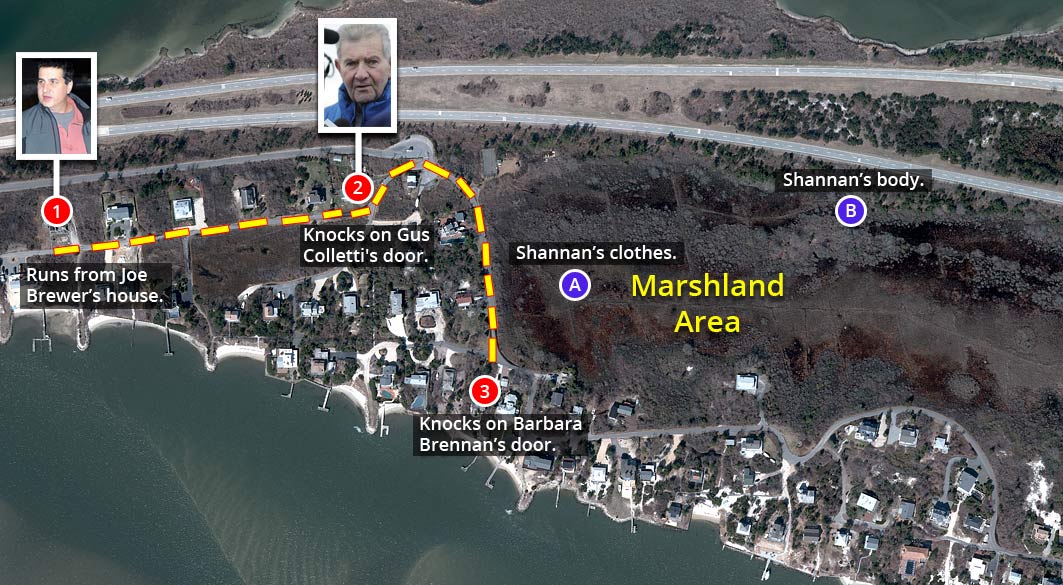It is unlikely that Shannan Gilbert was a victim of the Long Island serial killer (LISK).
Although her tragic death eventually led to the discovery of the killer’s dump site on Gilgo Beach, that is the only solid connection between her and the other victims.

Digitally enhanced photographs of Shannan Gilbert.
Many people react with confusion when they hear this.
Others become hostile because they are emotionally invested in Gilbert’s case. They have studied her death for more than a decade, and almost all of their LISK theories are centered around it.
Unfortunately, the media has not helped. Instead of making the facts crystal clear, they have often blurred the line between Gilbert and the other girls for the sake of clicks and entertainment.
For example, the film Lost Girls (2020) is the only movie about the Long Island serial killer case. However, it spends the vast majority of its time focusing on the one person who probably isn’t a LISK victim. The other women merely serve as a backdrop.
Did someone murder Gilbert? It is somewhat possible.
Was that person LISK? The likelihood is no.
“Bad guys” can exist at the same time. Furthermore, violence against sex workers is nothing new.
The discovery of the Gilgo Four.
When Gilbert went missing from Oak Beach in May of 2010, canine police officer John Mallia and his cadaver dog “Blue” started looking for her.
For months, they searched the overgrown terrain around Oak Beach. However, they were unable to find any trace of the missing sex worker.
Six months after Gilbert disappeared, the officer decided to return to the island and search again. On that occasion, he ventured five miles west.
On December 11th, 2010, the pair were walking along a desolate stretch of road near Gilgo Beach when Blue became focused on a section of the thicket.
When Malia entered the bushes to investigate, he found a skeleton wrapped in burlap.
The skeleton did not belong to Gilbert. Instead, it turned out to be the remains of Melissa Barthelemy, a 24-year-old sex worker who had disappeared in July 2009.

The site where Mallia and “Blue” discovered Melissa Barthelemy.
A subsequent investigation of the area led to the discovery of three more bodies.
The victims were Maureen Brainard-Barnes, Megan Waterman, and Amber Lynn Costello—three sex workers who had vanished between 2007 and 2010.
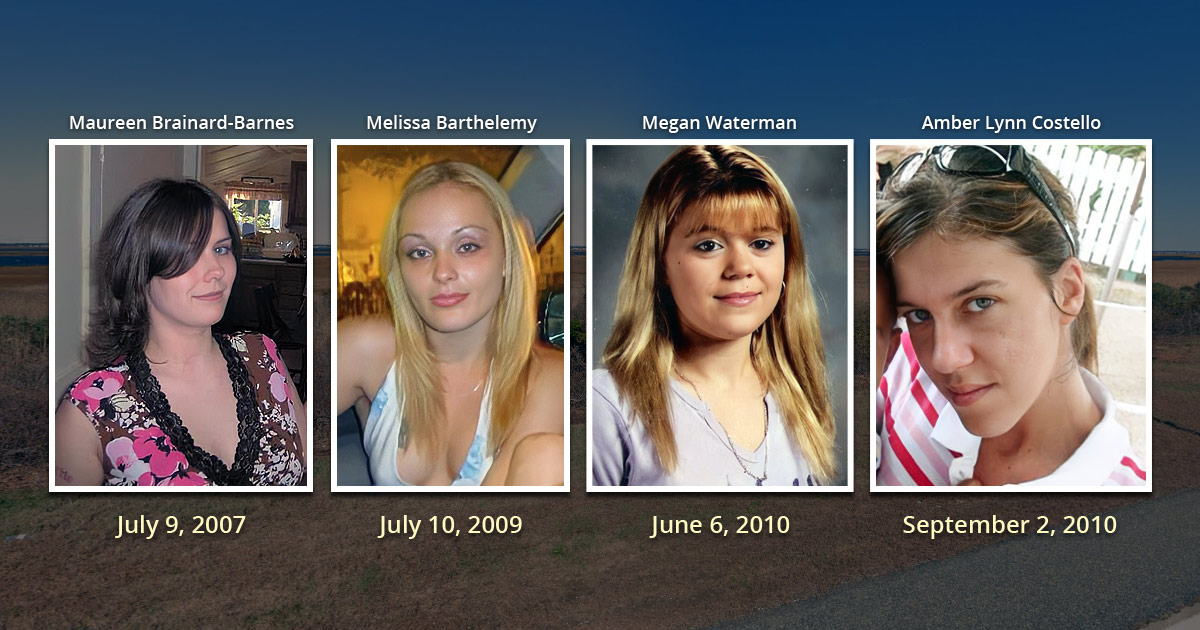
Photographs of the Gilgo Four.
At that point, it became clear that a serial killer had been using the roadside along Ocean Parkway as a dumping ground.
The discovery of Shannan Gilbert’s remains.
Although the authorities widened their search and discovered six more victims along Ocean Parkway, Gilbert was not among them.
She remained missing for another year.
It wasn’t until December 2011 that the authorities discovered her skeletal remains in a dense marsh near Oak Beach, close to the location where she was last seen.
When tabloids and podcasts cover this topic, they rarely point out the distance involved.
Gilbert was not found “next” to the other girls. She was actually found more than 3 miles (5 km) away from the closest dump site.
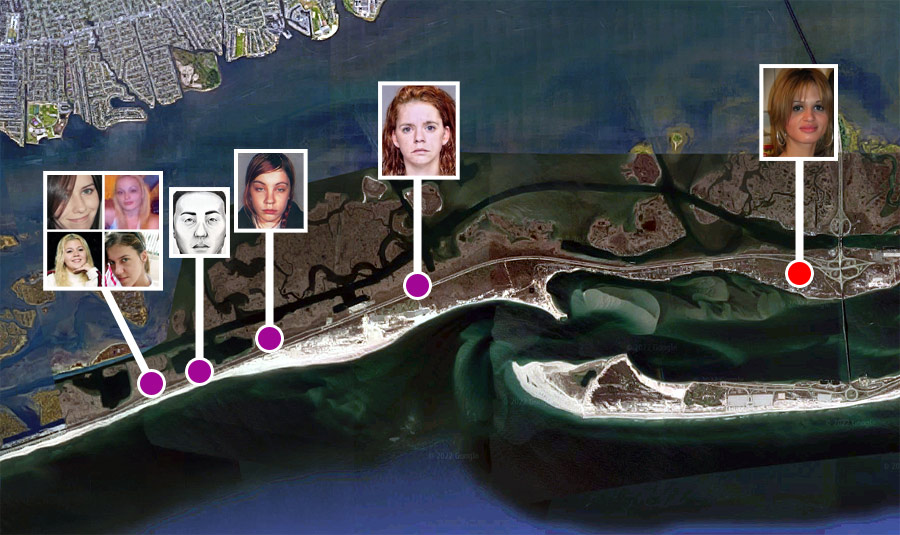
The police discovered Gilbert’s remains on the eastern side of the Island, roughly 5.5 miles away from the Gilgo Four. The closest LISK victim was Valerie Mack, who went missing in 2000.
Although her disappearance eventually led to the discovery of LISK’s victims, that does not mean that she was a LISK victim herself.
Gilbert isn’t a likely LISK victim.
The Long Island serial killer contacted the Gilgo Four using burner phones. He then lured them to places where he could pick them up without being seen.
This is why the Gilgo Four seemingly vanished into thin air.
This was a man who exercised caution and diligence.
After killing the women, he separated them from their belongings, wrapped them in burlap, and then placed them in the thicket beside Ocean Parkway.
In comparison, Gilbert’s death was completely different.
In Gilbert’s case, a client named Joseph Brewer used his personal phone to organize an out-call to his own private residence.
Gilbert then traveled to Brewer’s house with her own personal driver.
Afterwards, she called 911, ran away from her driver, banged on the doors of neighboring houses, and disappeared.

Shannan Gilbert’s driver, Michael Pak and her client, Joseph Brewer, were both investigated and cleared of any wrongdoing. At the start of the 911 call, they seemed fine with the fact that she was using her phone.
If Gilbert was a LISK victim, then it means that the killer decided to suspend all of his normal rules of operation:
- He left behind a digital trail that the police could easily trace.
- He decided to murder his victim after she had already called 911 and created a huge ruckus in the gated community.
- Following the murder, he left her body in a nearby marsh.
- He also made no effort to hide her ID or belongings.
None of this sounds like the work of LISK.
Judging by the recording of the 911 call, Gilbert was not thinking very clearly at the time.
She seemed paranoid and incoherent.
There seems to be a tendency to forget that Gilbert was believed to be bipolar, and that she had stopped taking her medication in high school because it reportedly “gave her the shakes.”
She was also awake for more than 24 hours in the lead-up to her disappearance.
When you consider all of the above, it seems very possible that she experienced a psychotic episode.
“But weren’t they all advertising their services on Craigslist?”
Gilbert and the Gilgo Four were using Craigslist to advertise their services. However, that connection is tenuous at best.
This would be similar to connecting victims on the basis that they all used cellphones.
By 2010, hundreds of escorts in the state of New York were plying their trade on Craigslist and similar websites.
Internet usage exploded during the 2000s. This was the decade when broadband, smartphones, 3G networks, and social media became the norm.
From about 2005 onward, almost every industry started to move online.
The sex industry was no exception.
In August of 2010, CNN reported that roughly 7,000 adult listings were being posted every single day. Earlier that year, the New York Times reported that staff members at the Illinois attorney general’s office had counted more than 200,000 ads since late 2008.
And that was just for Chicago.
For many escorts, Craigslist was the place to advertise their services, as it was one of the most popular websites in the United States.
Therefore, it isn’t shocking that Gilbert and the Gilgo Four were all using it at the time of their disappearances.
911 call.
For years, the Suffolk County Police Department refused to release the recording of Gilbert’s 911 call.
This fueled conspiracy theories, as many people felt that the authorities were trying to cover up the murder of a young woman.
The SCPD stated that Gilbert seemed calm at the start of her 911 call. They also theorized that she may have suffered a psychotic break.
After being granted permission to listen to the call in private, Gilbert’s family attorney, John Ray, contradicted these claims. He also accused the SCPD of deliberately making false statements:
“The tapes, if the public would know of them, would shock the public and probably upset the public.”
Ray’s comments added fuel to the fire and raised suspicions that a big conspiracy was afoot.
However, on May 13th, 2022, the SCPD suddenly released the call to the public.
Notably, there was no smoking gun. Nor were there any real shocks.
All in all, it appeared as though SCPD’s description of the call was a lot more accurate than Ray’s version of events.
Gilbert seemed incoherent and paranoid. At times, she was unresponsive and ignored the 911 operator.
One minute, she suspects that her personal driver is part of a conspiracy to kill her. The next, she is asking him to take her home.
She also refuses to leave the house of the man who supposedly wants to kill her.
Her driver, Michael Pak, seems genuinely puzzled by her behavior.
Meanwhile, the client, Joseph Brewer, clearly wants her to leave his house immediately. He wants nothing to do with the situation. He just wants Pak to take Gilbert with him and go.
Sadly, it seems as though this vulnerable young woman suffered a mental break and lost touch with reality.
How did Gilbert die?
The police believe that Gilbert ran into the dense marsh by Oak Beach before drowning or succumbing to hypothermia and/or exposure.
That night, she believed that someone was out to get her. Fearing for her life, she knocked on neighboring houses and continued running.
This prompted two separate 911 calls from Oak Beach residents, Gus Colletti and Barbara Brennan.
The last confirmed sighting of her was at Brennan’s house at roughly 5:40 a.m.
It is likely that she entered the marsh shortly after knocking on Brennan’s door.
This was not a nice place to be. Not only was it wet and cold, but it was filled with tall reeds that would test anyone’s sense of direction.

This video still shows what it would have looked like from Shannan Gilbert’s perspective. Note that it was brighter than this, as sunrise was 10-15 minutes away.
By the time she reached the marsh, it is likely that she was in such a frantic state that she didn’t put much thought into which direction she was going.
She may have died from hypothermia.
Many people wrongly assume that hypothermia only occurs in cold weather. However, this is not the case. In reality, it can occur in any environment that is colder than your normal body temperature.
This is especially true if you are exposed to water, as water speeds up the process by conducting heat away from your body.
When Gilbert entered the marsh, the temperature was between 52 and 55°F (11 and 12°C). It wasn’t until roughly two hours later that it rose above 60 °F.

Historical weather data from nearby Ronkonkoma.
The Mayo Clinic states that a person’s tolerance for cold temperatures diminishes when they are fatigued.
By the time Gilbert entered the marsh, she had been awake all night. She had also been running around the gated community in fear for her life.
Therefore, it stands to reason that she was pretty exhausted.
Her fatigue, the cold temperature, the tall, dense reeds, and the wet conditions of the marsh would have undoubtedly put the 23-year-old in a very dangerous position.
As her body temperature started to drop, she would have grown even more confused than she originally was. Hypothermia can jumble your thoughts, sap your energy, and impact your motor skills.
One of the worst parts about this condition is that the sufferer usually isn’t aware of what is happening to them. Instead, they go into a gradual downward spiral that they are unable to save themselves from.
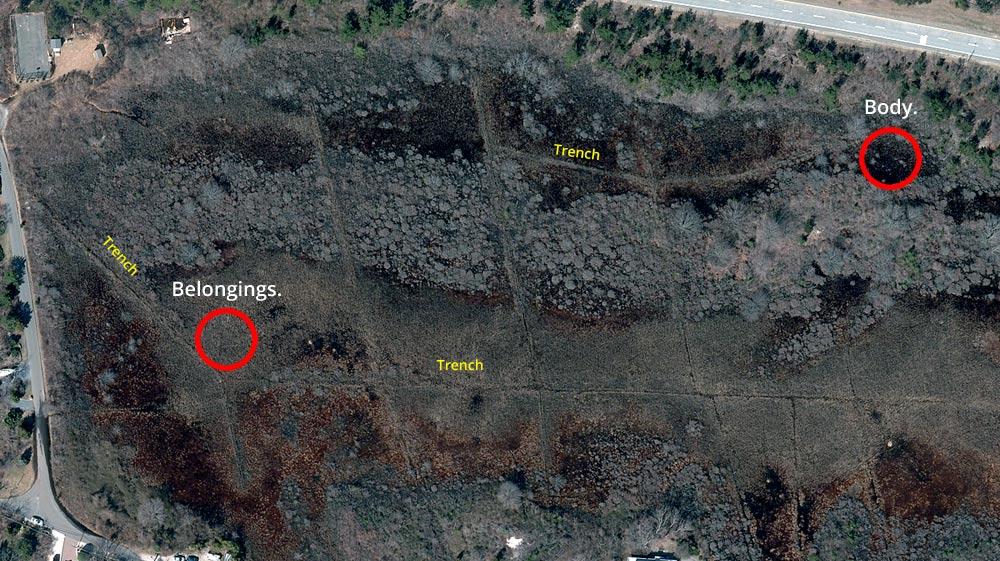
This marsh is more than 1.2 million sq ft in size. That’s similar to 20 football fields. Click on the image to view the full version.
The police discovered Gilbert’s clothes 300 yards (280 meters) away from her body. This is telling, as hypothermia is associated with a phenomenon known as “paradoxical undressing”.
To make a long story short, people with hypothermia will sometimes begin to feel that they are burning up, even though the opposite is happening.
Confused and feeling overheated, they will begin to tear off their own clothes.
Tragically, this “disrobing” speeds up the process and lowers their body temperature even further.
“Didn’t a coroner say that someone strangled her?”
No, not exactly.
In her autopsy report, the Suffolk County Medical Examiner noted that there was no evidence of trauma.
However, Gilbert’s family and her attorney refused to accept these findings.
Consequently, they hired “famous” forensic pathologist Michael Baden to conduct an independent autopsy.

Michael Baden.
In Baden’s report, he concluded:
“There is insufficient information to determine a definite cause of death, but the autopsy findings are consistent with homicidal strangulation.”
The first problem here is that he doesn’t fully commit himself to such a conclusion. Instead, he suggests it by saying that the rough margins around the hyoid bone were consistent with strangulation.
The second problem is that Baden has a history of making dubious claims. Over the years, he has picked up a reputation for being a “celebrity” pathologist who makes a living out of contradicting coroner’s reports:
- During the murder trial of O.J. Simpson, he made two far-fetched claims that he was later forced to disown. These claims aided the defense team and helped them secure Simpson’s acquittal. He denied making one of these claims until video footage of his testimony was played back to him.
- While he was giving evidence in the murder trial of Phil Spector, the prosecution team asked him if he had any conflicts of interest. Although Baden said that he couldn’t think of any, it was later revealed that his wife was one of Spector’s attorneys.
- Medical experts criticized his assumptions in the case of Jeffrey Epstien.
- He made statements about the death of Michael Brown without having access to key evidence such as x-rays.
- One pathologist told NBC News that Baden has a habit of making statements that are not accurate.
Notably, in his report on Gilbert’s death, he states that the 23-year-old was still wearing blue denim jeans. However, this is incorrect, as her jeans were actually discovered 300 yards away in another part of the marsh.
The hyoid bone.
After the police released Gilbert’s 911 call, her family attorney, John Ray, suddenly revealed that there was a “drill-shaped hole” in her hyoid bone.
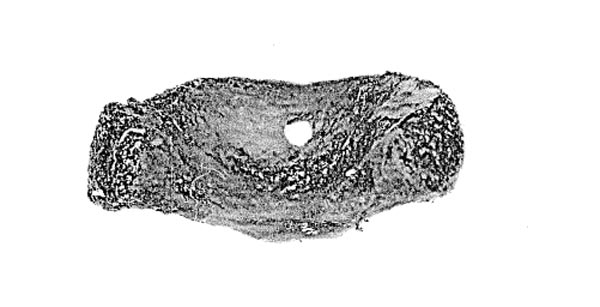
An autopsy photograph of Gilbert’s hyoid. This bone is from the midline of the neck.
During a radio interview on “On LI In The AM”, Ray claimed that someone created this hole using some kind of instrument:
“When somebody gets strangled, those (hyoid) horns crack and snap off. Those horns are gone. And there’s a hole drilled right through the middle of the hyoid bone by some kind of instrument. Whether it was a needle or a drill, we don’t know.”
Here, Ray is suggesting that someone went through the effort of drilling a neat 4.7mm hole into Gilbert’s hyoid before strangling her.
This theory sounds far-fetched and disjointed. It does not make sense.

John Ray.
After opining that someone drilled a tiny hole into her neck, he went on to say the following:
“The medical examiner from Suffolk County said it’s a lesion. Which means that it is a defect. And they don’t know what. They don’t know why it’s there. And then they left it alone.”
This statement is misleading, as it suggests that medical examiner didn’t offer any explanation about what might have caused the hole.

A screenshot from Shannan Gilbert’s autopsy report.
As you can see, the report explains that this “lesion” may be the result of a thyroglossal duct cyst or something similar.
Although these kinds of cysts are relatively rare, they do occur in 7% of people. Furthermore, many cases are asymptomatic.
This means that Gilbert may have had this kind of cyst (or the remnants of one) without even realizing it.
Notably, Baden’s independent report did not contradict the Suffolk County Medical Examiner’s view on this lesion.
In fact, his report didn’t even mention the hole at all.
This begs the question:
If two forensic pathologists didn’t raise any suspicions about this hole, then why is Ray suggesting that someone created it with a medical instrument or drill?
This case contains a lot of misconceptions and half-truths.
The problem with unsolved cases is that many online commentators will repeat other people’s theories and misconceptions as fact.
Let’s take a look at a few examples of this.

The hyoid was not missing—only the horns.
Furthermore, many other bones were missing as well. These included 4 carpals, 1 metacarpal, 10 hand phalanges, 1 tarsal, 2 metatarsals, and 20 foot phalanges. This was likely due to animal scavenging, as some of the smaller bones were found 40–50 feet away from the body.
People often forget that Gilbert’s remains were in that marsh for nearly 20 months. That is a very long time.

She was not found next to 14 other sex workers. The closest LISK site was more than three miles west. Furthermore, the police discovered 10 remains at Gilgo Beach, not 14.

The comment above suggests that Gilbert stumbled into a marsh full of murdered sex workers. However, this is false.
As you can see, there are a lot of “factoids” and misconceptions about this case.
The fact that certain people have been purposely muddying the waters all these years has not helped.
From the start, there has been a concerted effort by various parties to forcibly insert Gilbert’s death into the Long Island serial killer case.
Some have done so in an effort to draw media attention to her case (and possibly launch a wrongful death claim).
Others are motivated by the fact that all of their personal theories about LISK revolve around the tragic incident at Oak Beach.
Letting go of a theory that you’ve been certain about for years is not an easy task.
To compound matters, the Suffolk County Police Department has been pretty poor at communicating details about the case. Like many law enforcement agencies, they prefer to keep their cards close to their chest.
Even if it damages their public image.
“Isn’t it a coincidence that Gilbert died five miles away from the other girls?”
“The human mind delights in finding pattern—so much so that we often mistake coincidence or forced analogy for profound meaning.”
– Stephen Jay Gould.
Coincidences happen all the time.
In Gilbert’s case, it took 14 years for this “coincidence” to occur.
Right now, seemingly improbable events are happening all around you. However, you probably won’t notice any of them.
Take the following examples:
- The man who delivered your package this morning was your coworker’s brother.
- Last week, you stopped beside the car that your partner owned before you met them.
- That stone that you threw into a lake landed within 5 feet of a stone that someone else threw.
- The carpenter who built your parents’ garage has a daughter who sits behind you in one of your college lectures.
Would you notice any of these coincidences? Probably not.
For instance, Ted Bundy’s victims, Janice Ott and Susan Rancourt, knew each other because Janice had previously dated Susan’s older brother in high school.
Within the space of four months, both Ott and Rancourt fell into the clutches of America’s most notorious serial killer.
Furthermore, Bundy did not stalk these women. In both cases, he randomly selected them because his initial targets grew weary of him and backed away.
Simply put, this means that Ott and Rancourt were both in the wrong place at the wrong time.
The human brain will always look for connections. It is our way of trying to make sense of random events.
This is because we are not great at judging probability.
One of the biggest problems with the “true crime community” is that it often struggles to tell the difference between evidence and coincidences.
Shannan Gilbert is still a part of the LISK story.
Although it is unlikely that Gilbert was a victim of the Long Island serial killer, there is no denying the fact that it was her death that ultimately exposed him.
In a remarkable twist of fate, her untimely demise lifted the lid on a monster who had every intention of claiming more victims.
When she ran into the marsh that night, LISK and his dump sites at Gilgo Beach had gone undetected for more than 14 years.
By the late 2000s, he had become proficient at luring women to their deaths and making them vanish without a trace.
In his mind, he probably believed that he had perfected his “craft.”
It was a well-oiled machine, so to speak.
However, Gilbert’s tragic death proved to be the spanner in the works.
It was the one thing he didn’t see coming.
Because of that, she will always be a part of this case.
